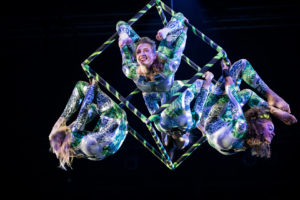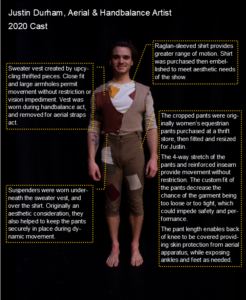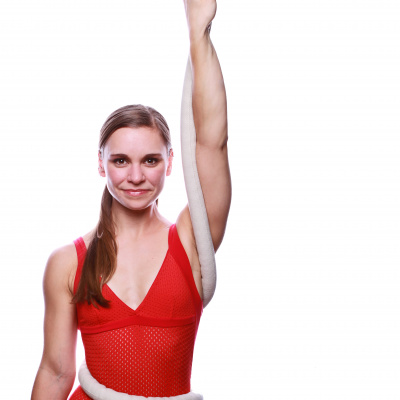Circus Costume Magic with Jenny Leigh Du Puis
The Designer Series is a set of articles dedicated to the people who bring color, light, architecture, ambiance, and sound to circus. Often they invent and construct in a shop, a studio, a tech booth — unobserved by the standard circus patron, yet essential to the circus experience. These professions exist in many art forms, but this series digs into what it means to be a circus designer and celebrates their contributions to the community. In this series I also aim to glean from my interviewees and share with my readers what it takes to start, develop, and succeed in a circus design career. Secondly, I wanted to hear — straight from the source — best practices for communication amongst production teams to both honor the expertise of circus designers and make the show creation process as smooth as possible.

This month, I spoke to Jenny Leigh Du Puis, costume designer extraordinaire. Because of the extreme athleticism, body-to-body or body-to-apparatus contact that occurs in most disciplines, circus costumes do far more than simply clothe a performer. They are part of the performer’s safety, they are an engrained part of the story telling, and they are integral to character development. These specificities are seen in the long history of circus performers designing and building their own costumes. Du Puis explained how in small or familial companies, there is an apprenticeship models where more experienced performers taught newer performers the tactile skills necessary to make costumes. This practice is still active today, but in larger, more corporate settings, it has waned. The spectrum of people who are involved in creating costumes for a large production is wide, and there is a depth of expertise to be learned at every layer of the process. In a quippy moment during our conversation, I asked Du Puis to humor me, “Thinking about one of these larger contemporary productions, could you list all the people that might have something to do with how a rhinestone gets on a performer’s butt? Just how many humans are we talking about here?” To my delight, she laughed, and enthusiastically obliged.
“The Designer starts with the ideas. In the costume shop the designer will have an Assistant. The Assistant will work with the Costume Shop Manager. The Costume Shop Manager will communicate the schedule and the needs to the Drapers, the Tailors, the First Hands, the Stitchers, Costumes Crafts — which can include shoes, millenary, dying, armor, leather work feather work, embellishments like hand-beading, rhinestoning, that kind of thing. The sketch is given to the Draper or Tailor and cut out by the First Hand, assembled by the Stitcher. Someone is in charge of fittings which they will conduct with someone taking notes for them. As a side step someone has to take the measurement of the artist in the first place.” So far, I had tallied nine roles, noting that multiple people might be hired to do one role. I stopped counting as Du Puis moved on to jobs that required whole teams.
“There is someone who might do a 3-D body scan of the artists head we use to make plaster casts of their heads. That could be an anthropometrics team. There may be a separate team that conducts the alterations or it may be the Stitcher. Once the costume leaves the costume shop it’s then shipped to the show.” Due Puis then started to rapid fire, “Wardrobe Head of Department, Assistant Head of Department, Shift Lead, Stitchers working under them, Wigs Head of Department and maybe an Assistant. Makeup might be a separate thing. Shoes will have a couple people. Heads will have a couple people – those are folks trained in millenary. Stitchers will come in for special projects, major alterations, and repairs. Wardrobe attendants also know how to sew and will do minor repairs, laundry for the costumes, preset all the cues, run the tracks, zip and unzip sweaty acrobats in their unitards all night, do all the laundry at the end of the night… I really hope I’m not missing anyone!”
My point of including this lengthy list is to offer the community, as Du Puis said, “a snap shot of all of the people that can have some kind of relation to costume,” and by doing so, show how many different ways someone can be involved in circus. Du Puis clarified that, “Things work in a linear system but also in tandem with other departments who might liaise,” and that a lot of positions might overlap. Costumers must be multi-faceted, just as the avenues to a costume job has many routes.

“Hello! I would shake your hand, but mine are covered in cake!” said a man named Ozzie to Du Puis. It was an apropos, whimsical welcome to circus. Ozzie worked at Circus Smirkus, and Du Puis had just arrived for her new position as a Stitcher for the summer season. She had just earned her undergraduate degree in apparel and fashion design from La Salle University. The job at Smirkus tumbled into the next, and it has been non-stop for Du Puis ever since. “I built up my skill sets really quickly with construction in that first stitching job. You get the basics in your undergrad degree, but then you really don’t know how to sew until you go out into the world and work.” Her experience ranges from regional theaters to touring productions, charity work to an Etsy shop, circus schools to Cirque du Soleil. At some moments in her career, Du Puis admitted that people took a chance on her; she cold called or dropped her resume in people’s lap without prior connections. But she also mentioned, “The biggest way that people get jobs in entertainment is networking — often without knowing that you’re networking. Generally just being a good human being who is diligent and passionate about the work that they do.” This too has been a large part of Du Puis successful trajectory.
But it hasn’t always been a sunny ride for Du Puis. She shared with me a cautionary tale that she often tells to her students. “I was sewing over 80 hours a week. It was just too much, and I wasn’t taking care of my body. I blew out my shoulders from too much sewing before I turned 30 due to repetitive motions from the body positioning of being at a sewing machine.” This ended Du Puis’ career as a stitcher far earlier than most. She shifted her focus back to academia, an interest that was always brewing in the background. “I went to Auburn, Alabama, and got my master’s in Consumer and Design Sciences with a focus on apparel design.”

Du Puis summarized how her combination of formal education and industry experience led her to her current pursuit, a PhD at Cornell University. “My undergraduate degree in fashion taught me to make patterns, work with fabric, and turn an idea into a sketch then into a garment. My work experience taught me how to sew, work with fabric, and work with people. My masters taught me about consumer behavior research, how to formalize evaluations — which is not as essential in the industry, but academia really likes it. My PhD is titled Safety and Function of Attire for the Extreme Physical Performance of Circus Arts. I’m looking at the past, focusing on circus costume history and how it’s evolved over time. I’m looking at the present through a series of interviews with living circus asking, what are people wearing right now; what are their past experiences; what are their concerns; how do they get these garments? And the future is about looping in wearable technology.”
I took some time to nerd out with Du Puis about circus and academia, but then corralled us back to an important questions I had. “How does someone start being involved in the circus costume industry?”
“Some people learn [to sew] from the moment they can walk. My training went formal, and that gave me certain skill sets. People who don’t go through formal training can get the exact same skill sets just from a different route. And we can have the same level of talent and skill and be able to execute the same projects. Sewing starts at a basic level. It will be frustrating, it’s like any skill and it will not happen overnight. You have to work at it. To the person who has never sewn before I would recommend they look in their closet to identify the kinds of clothes they most often wear. Those garments will make the most sense to them in terms of shape when you start constructing. If you have a piece you can maybe sacrifice to cut apart at the seams, lay out, and see what shape that makes, that will start to make the connection. A garment is just a 2-D piece of fabric wrapped around a 3-D form, which is the body.” Learning from an experienced mentor is ideal, but Du Puis also mentioned that many of these basic skills can be learned from YouTube.
But YouTube will only get you so far. To truly become a circus costume designer or builder takes insider knowledge. Du Puis explained, “People in circus have the knowledge, and those of us who had adjacent careers and then became part of the circus community through our work brought some skills with us that adapted to the knowledge of circus. These specialized skill sets and training are from circus itself, and it’s only so much you can learn outside of it that you can bring to the table. Then you have to revise your skills set to adjust to the needs of circus. It’s everything: from knowing which direction of stretch to cut this unitard — do I need to go up the body or around the body? — to the technique of sewing sequences secured at the four cardinal points and tied off so that you can have the sparkles but it won’t affect the stretch of the garment. There are some costume magic that I’ve learned through my career or my research that I will never give out to the world because that’s not my place — that’s circus magic. There are specialized techniques that need to stay in circus.”
My final question for Du Puis concerned best communication practices between members of a production team. She responded from the point of view of her academic research as well as her experience in the field. “Safety and function has to come first. That’s your foundation,” she began. “Open communication from the start, realistic expectations of time, budget, number of pieces, the scale to which things can be elaborate or need to be paired down for restrictions of time, labor and cost.” She also emphasized the importance of having a “common working vocabulary” so that all aspects of the show and the needs of circus were clear amongst all participants. She concluded by summarizing, “It’s managing the expectations of the production schedule and utilizing your skill sets as a project manager and team leader to bring costume’s voice to the table as an equals representative. Everyone has to be able to talk to each other cogently about the costume that’s going on the performer. At the heart of it is the performer whose body is wearing the costume. At the end of the day, the last thing the performer needs is to be thinking about their costume when they are in the middle of a precarious part of their act. I like to tell the people I design for is that the last thing you should be worrying about is the thing that you’re wearing on stage.”
And in that is the circus magic that designers bring to the stage. Their expertise and craft must be (pardon the pun) so seamless that their work becomes enveloped in the greater performance. Not invisible, but so in tune with the actions of the performer, so complimentary with the lights and set design, that instead of the audience seeing a performer in a costume, they see a character in natural garb for the world they inhabit and the story that they tell. This, to me, is the true magic that people like Du Puis bring to our art form.
...Do you have a story to share? Submit your news story, article or press release.





